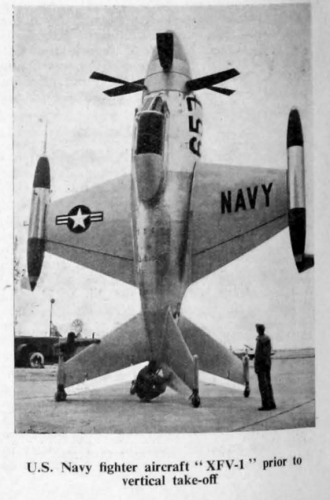Also known as the vertical flight research rig or the Thrust Measurement Rig (TMR) - the zany contraption first appeared in these pages 64 years ago this week, having made its maiden, free flight on August 3rd 1954. The same issue featured a vignette on Lockheed’s XFV-1, a vertically launched fighter aircraft developed for the US Navy. According to our predecessors, technology had only just matured to the point where VTOL flight was becoming a reality, powered primarily by the advent of the jet engine.

“The prospect of launching an aircraft vertically using only the engines provided for its level flight requirements, has been brought much nearer reality in recent years by the rapid evolution of the gas turbine,” The Engineer wrote. “Since the Whittle ‘W.1’ engine of less than 1,000lb thrust, the specific thrust has been raised from about 1.5lb per pound weight to that of nearly 4lb per pound weight in the latest turbo-jet engine in the 10,000/15,000lb thrust category. These increases have also been achieved without diametral growth. An aircraft with two such engines mounted in the fuselage, could therefore be designed with sufficient thrust to accelerate vertically from rest.”
READ THE ORIGINAL ARTICLE HERE
Whereas the American XFV-1 used counter-rotating propellers powered by twin gas turbines to generate its vertical lift, the UK research rig applied techniques more akin to the F-35B’s V/STOL capability. Its two Rolls-Royce “Nene” turbojet engines – each producing around 500lb of thrust - were mounted horizontally within a steel frame, but the jets were ducted through 90 degrees so that the thrust was directed vertically downward. This vectored thrust was described by The Engineer as “a favourable arrangement for balancing the device and eliminates gyroscopic effect.”
The framework sat upon four legs that used castors for wheels, with the pilot perched on a platform above the two engines, using a conventional control column and rudder bar to steer the vehicle with jets of compressed air from nozzles in the cross-arms. It sounds like a fairly rudimentary control system and certainly not one for the faint-hearted. In fact, the sole purpose of the research rig was to investigate the issues around controlling a VTOL craft, and initial tests saw the flying bedstead tethered to the ground in an effort to enhance both pilot and machine safety. The August 3rd flight marked the first time the TMR was allowed to fly untethered, described below:
“It remained airborne for nearly ten minutes and during this time it moved about over the ground under the pilot's control at heights of from 5ft to 10ft, returning finally to alight at its starting point. For subsequent flight it has been flown free at heights up to 25ft.”
Vectored thrust VTOL aircraft have of course evolved significantly since the days of the flying bedstead, most famously perhaps with the Harrier Jump Jet. The Harrier, in various guises, has been in continuous service since the 1960s and is considered the only truly successful V/STOL to emerge from that era, despite being limited to subsonic airspeeds. Its natural successor, the F-35B, is capable of speeds in excess of Mach 1.6, but requires a short ski-slope to launch from carriers before landing vertically. The UK has publicly committed to buying 138 F-35Bs, though so far just 15 have been delivered.





Nanogenerator consumes CO2 to generate electricity
Nice to see my my views being backed up by no less a figure than Sabine Hossenfelder https://youtu.be/QoJzs4fA4fo